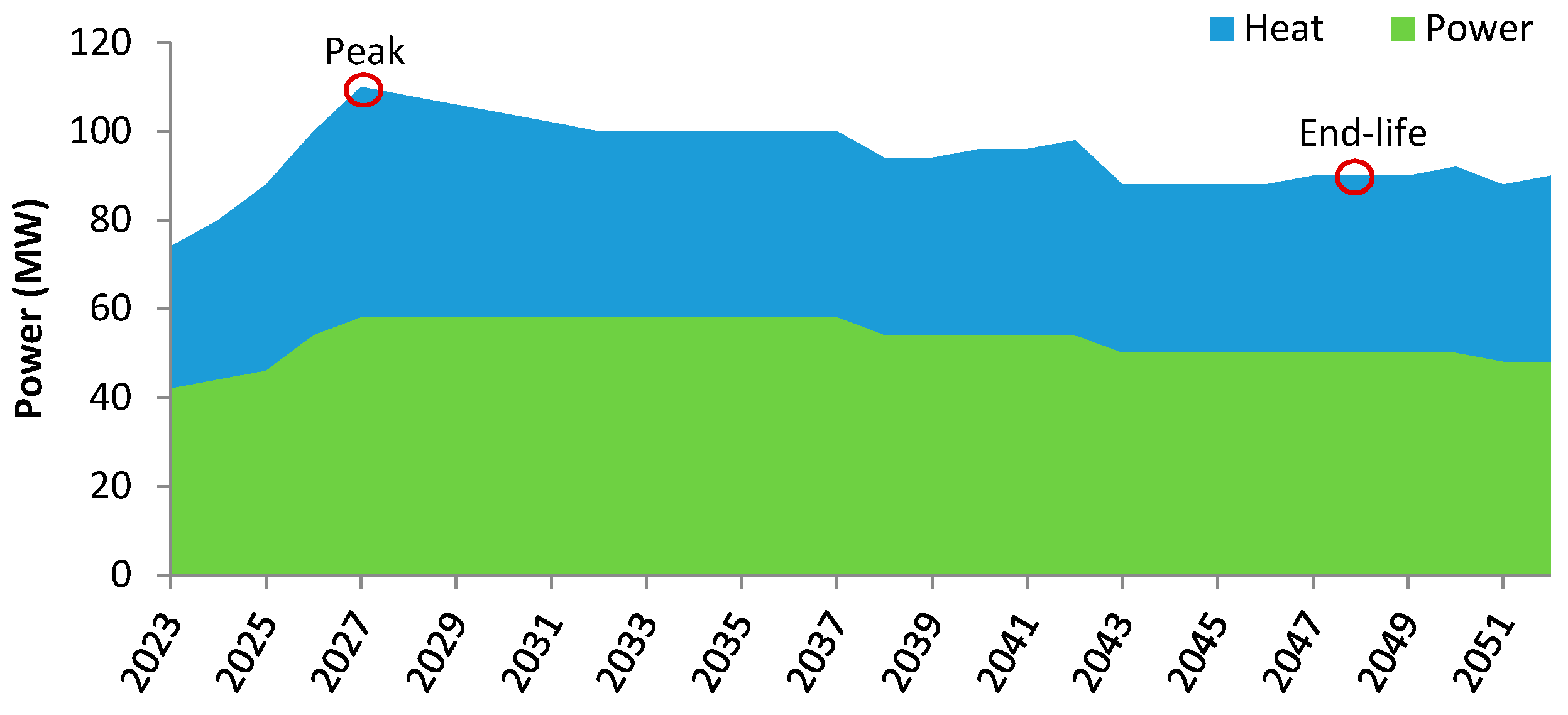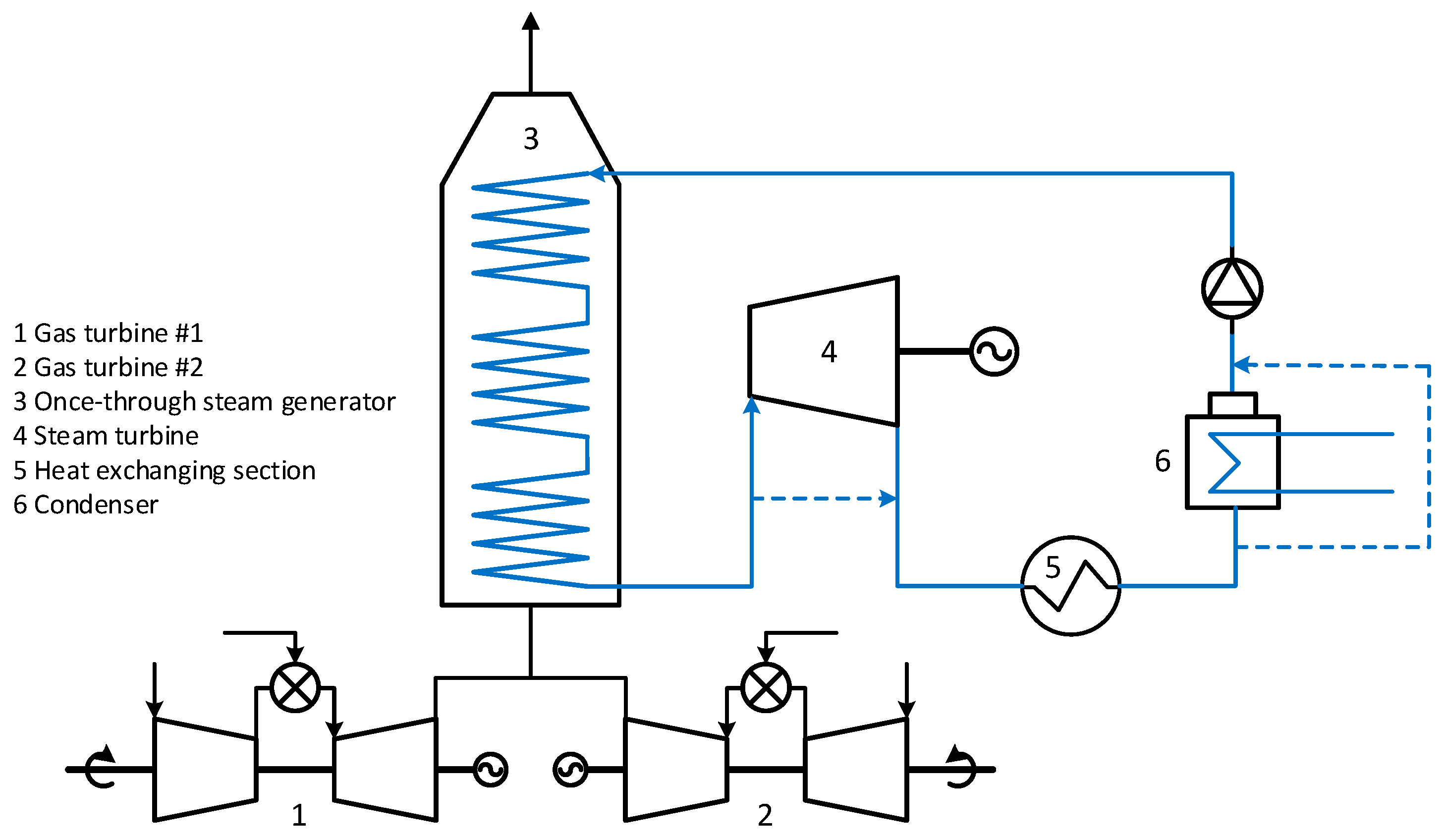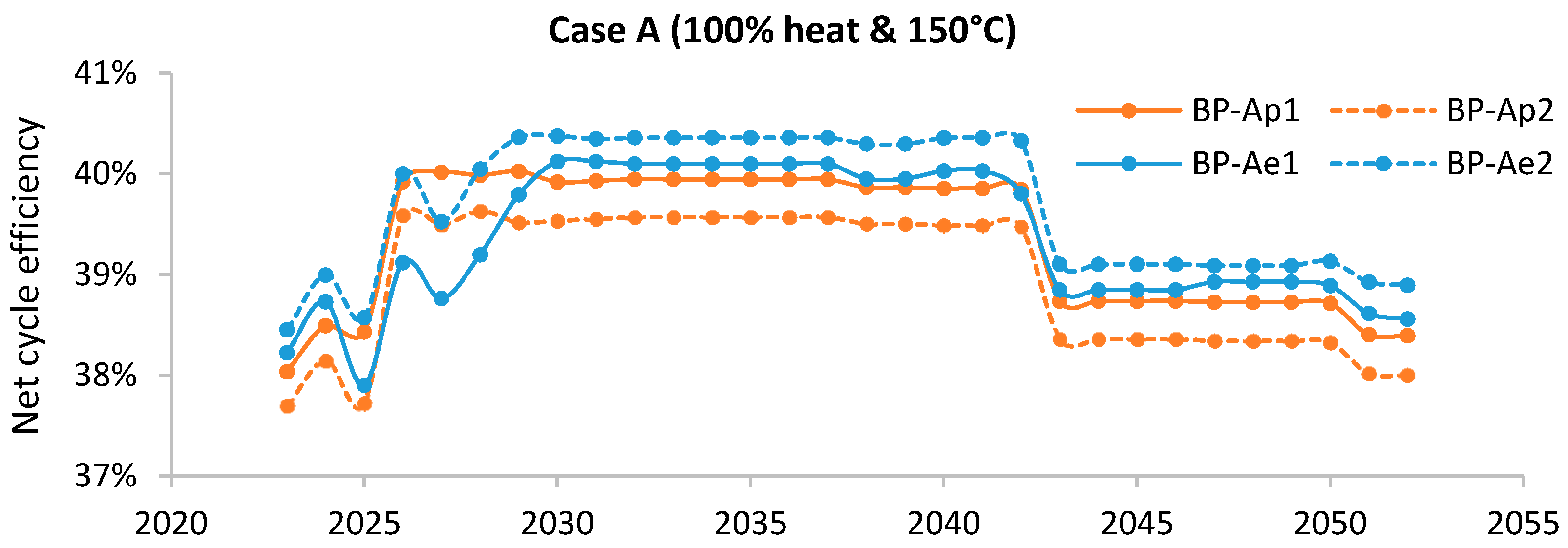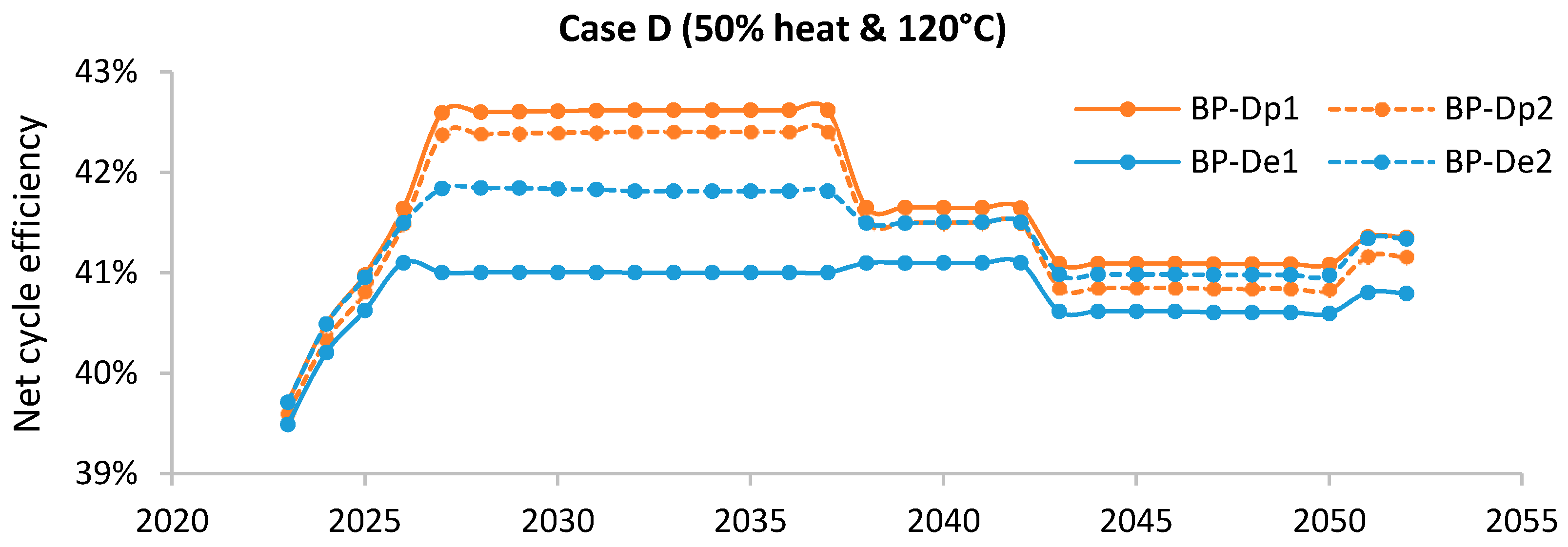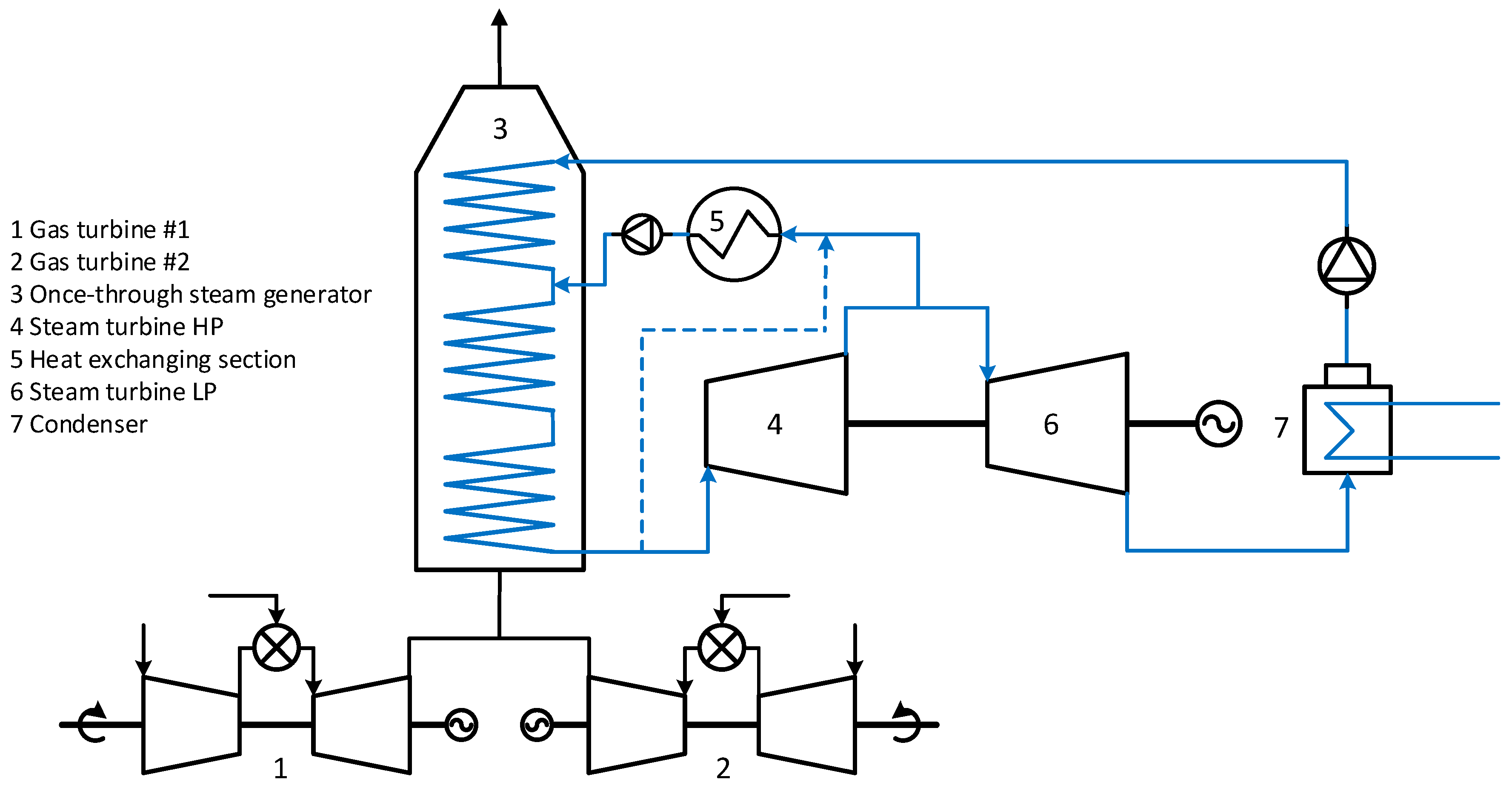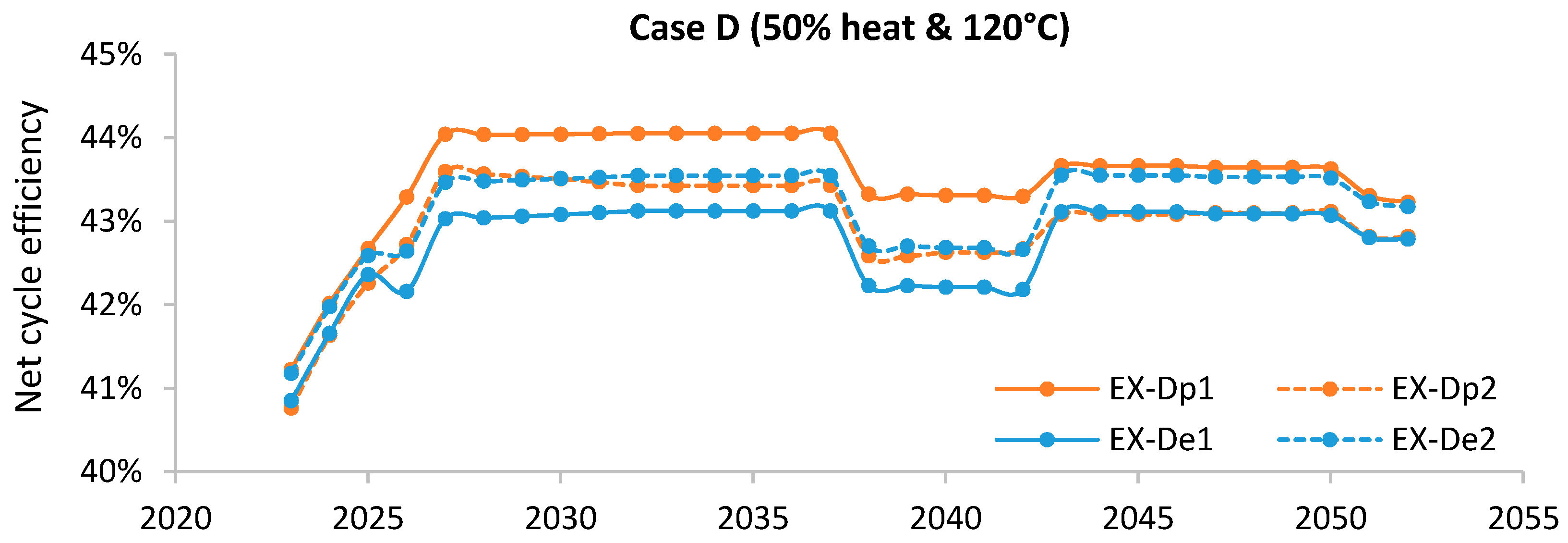The offshore extraction and processing of oil and gas is an energy-intensive sector, with significant power and heat requirements. It is common practice to use a fraction of produced gas in order to generate power onsite by means of gas turbines. This approach demonstrated to be an effective concept to locally produce the power necessary to meet the requirements connected to the offshore plants operation. On the other hand, the utilization of produced gas decreases the amount of gas that can be exported and gives local emissions of CO
2 resulting from the gas combustion. Therefore, an improved energy management entails environmental and economic benefits. Various analyses have been carried out in order to identify opportunities for increasing the energy efficiency of these plants [
1,
2,
3,
4,
5,
6]. The processes to be implemented and, accordingly, the design of an offshore plant depend to a large extent on the characteristics of the reservoir to develop. For this reason, the outcomes of energy and exergy analyses are often site-specific and cannot be generalized. However, both Nguyen et al. [
1] and De Oliveira and Van Hombeeck [
5] stressed the importance of an efficient utilization of the exergy associated with the exhaust gases of gas turbines. The common strategy consists of exploiting the thermal energy available in the hot gases to meet the process heat demand of the plant by means of a waste heat recovery unit (WHRU). The introduction of WHRU improves the energy efficiency of the plant and nowadays WHRUs cover a large share of all heat demand for offshore operations. A further step ahead in the direction of an efficient energy management could be made if the waste heat of the gas turbines is used as heat source for a bottoming cycle. Several works investigated the feasibility of offshore bottoming cycles. Kloster [
7,
8] argued that the adoption of combined cycles based on a steam bottoming cycle are the most viable option to improve energy efficiency and cut CO
2 emissions. Three projects, developed on the Norwegian continental shelf (Oseberg, Eldfisk and Snorre B), are described to stress the technical and economic feasibility of the technology. Nord and Bolland [
9] investigated the challenges associated with the installation of a steam bottoming cycle offshore. Requirements like compactness, weight limitations and flexibility have to be considered in the design of these cycles. Once-through heat recovery steam generator technology was evaluated as attractive for offshore applications and the performance of a cycle was tested with design and off-design simulations [
10]. A refinement of the design for such steam bottoming cycle was also presented, based on a detailed combined cycle model and numerical optimization tools [
11]. The solution with minimum weight-to-power ratio was determined, alongside with the Pareto frontier of solutions with maximum power and minimum weight. Besides focusing on the ways to design compact and low weight steam cycles, it is critical to analyse the site-scale integration of such technologies. Nguyen et al. [
12] carried out a systematic analysis on steam bottoming cycles for offshore applications. The thermoenvironomic (i.e., energetic, economic and environmental) performance of combined cycles was assessed, together with the possible integration schemes at a site-scale level. Given the range of temperatures at which the waste heat could be available, other working fluids could become competitive with steam. Pierobon et al. [
13] investigated the most suitable waste heat recovery technology for a specific offshore facility. The technologies analyzed were steam Rankine cycle, air bottoming cycle and organic Rankine cycle (ORC), with their respective designs defined through a multi-objective optimization process. Steam Rankine cycles and organic Rankine cycles demonstrated to be competing technologies when targeting at the design of highly-efficient offshore platforms. The air bottoming cycle was evaluated as less attractive. The design of optimal organic Rankine cycle was further studied with regard to an offshore oil and gas platform in the North Sea. A first screening, based on a dynamic model, allowed to discard solutions which did not comply with the dynamic requirements of the system [
14]. The optimal designs were then determined through a multi-objective optimization methodology, which considered thermal efficiency, total volume of the system, and net present value as objective functions [
15]. Taking as case study the same offshore installation, a methodology were proposed for optimization of axial turbine design as a function of the ORC conditions [
16]. A systematic analysis on the utilization of ORC cycles for offshore applications was carried out by Bhargava et al. [
17]. The thermodynamic performance of three cycle configurations, combined with different power rating gas turbines, was studied and compared. Barerra et al. [
18] studied the utilization of an organic Rankine cycle on board of a Brazilian floating production, storage and offloading (FPSO) unit. The benefits of the combined cycle were evaluated at different field conditions. An organic Rankine cycle was also evaluated for the revamping of an existing upstream gas facility, in parallel with other options for an increased energy efficiency (e.g., substitution of a gas turbine driving a gas compressor with an electric motor) [
19]. Walnum et al. [
20] evaluated the viability of CO
2 bottoming cycles. The high working pressure implied an increased compactness of the cycle, while a 8% to 16% lower power output was obtained in comparison to a steam bottoming cycle. The simulations also showed an advantageous off-design performance. Mazzetti et al. [
21] evaluated that applying a combined cycle technology based on a CO
2 bottoming cycle could result in a 22% CO
2 emissions reduction over the 18 years of operation of the case study considered. Most of these studies focused solely on power generation. However, offshore installations are often characterized by significant requirements of process heat. Combined cycles offer the possibility to cogenerate power and heat, although a cogeneration layout, especially when heat at high temperature is requested, decreases the power output of the steam turbine. A cogeneration layout demonstrated to be feasible for offshore and other similar applications [
22]. An additional challenge in offshore applications consists of the variability of power and heat requirements, which are influenced by the oil and gas production profiles. As a consequence, offshore plants operate off-design most of their life, with a negative impact on the energy efficiency. A specific set of operating conditions needs to be selected to design a combined cycle. Nguyen et al. [
23] discussed how the integration of a steam Rankine cycle is more challenging at peak conditions, due to the peak heat requirements associated with the higher production rate of hydrocarbons. This strategy ensures the cycle capability to meet power and heat demands in each expected operating conditions but the end-life period would be characterized by a substantial efficiency decrease. An effective design should be able to perform efficiently in the several operational modes to which the plant will be subjected, rather than only at specific conditions. Similar considerations were made for marine applications, since ships can have very variable operational profiles. In this field, some advanced studies were presented. Kalikatzarakis and Frangopoulos [
24] developed a multi-criteria approach to the design of an ORC which took into account the operational profile of the ship. In an attempt to further investigate the influence of accounting for the operational profile, Baldi et al. [
25] proposed a procedure for the optimization of a combined Diesel and ORC system design. The method demonstrated to be advantageous in terms of fuel consumption compared to a case where only the performance at the design point was considered.
The aim of this paper was to provide a first assessment on the effectiveness of combined cycles for cogeneration of power and heat in offshore oil and gas installations. To the authors’ knowledge such assessment is missing in the literature which so far focused on combined cycles for production of only power. Backpressure and extraction steam turbine cycles were considered in the analysis. The first step to fulfill the main objective of the paper was to define a methodology to pinpoint the optimum combined cycle design, by taking into account the entire plant’s lifetime with its varying energy requirements. For that purpose, designs were developed to perform efficiently either at the peak conditions of the plant (peak production rate of crude oil with high plant energy requirements) or at the end-life of the plant (long tail-period of reservoir depletion with reduced plant energy requirements). The definition of the optimum designs was based on a constrained multi-objective optimization process, while the lifetime performance was obtained through off-design simulations. Once evaluated the general feasibility and established the design approach returning the best lifetime performance, the relative effectiveness of the cycles was assessed through a comparison with the reference case of a simple gas turbine cycle. The basis of the whole analysis was an actual offshore plant in the Barents Sea, with its predicted power and heat requirements throughout the field’s lifetime. In order to provide a more complete overview, other scenarios of power and heat requirements were also proposed and investigated.






